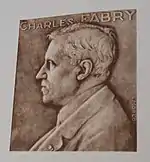Maurice Paul Auguste Charles Fabry | |
|---|---|
 | |
| Born | 11 June 1867 Marseille, France |
| Died | 11 December 1945 (aged 78) Paris, France |
| Education | École Polytechnique University of Paris |
| Known for | Fabry–Pérot interferometer Ozone layer |
| Awards | Janssen Medal (1916) Rumford Medal (1918) Henry Draper Medal (1919) Franklin Medal (1921) Prix Jules Janssen (1929) FRS (1931) |
| Scientific career | |
| Institutions | Sorbonne University of Marseille École supérieure d'optique |
| Thesis | Théorie de la visibilité et de l'orientation des franges d'interférences (1892) |
| Notable students | Jean Dufay Yves Rocard Bernard Lyot Yan Jici Sisir Kumar Mitra Anil Kumar Das Jean Cabannes Daniel Chalonge |
Maurice Paul Auguste Charles Fabry ForMemRS[1][2] (French: [fabʁi]; 11 June 1867 – 11 December 1945) was a French physicist working on optics.[3][4] Together with Alfred Pérot he invented the Fabry–Pérot interferometer. He is also one of the co-discoverers of the ozone layer.
Biography
Studies

Fabry graduated from the École Polytechnique in Paris and received his doctorate from the University of Paris in 1892, for his work on interference fringes, which established him as an authority in the field of optics and spectroscopy. In 1904, he was appointed Professor of Physics at the University of Marseille, where he spent 16 years.
Career

In optics, he discovered an explanation for the phenomenon of interference fringes. Together with his colleague Alfred Pérot he invented a new interferometer in 1899, now known as the Fabry–Pérot interferometer.[5][6][7] He and Henri Buisson discovered the ozone layer in 1913.
In 1921, Fabry was appointed Professor of General Physics at the Sorbonne and the first director of the new Institute of Optics. In 1926 he also became professor at the École Polytechnique. He was the first general director of the Institut d'optique théorique et appliquée and director of "grande école" École supérieure d'optique (SupOptique).
Fabry was the President of the Société astronomique de France from 1931–1933.[8]

Awards and honors
For his important scientific achievements he received the Rumford Medal from the Royal Society of London in 1918. In the United States his work was recognized by the Henry Draper Medal from the National Academy of Sciences (1919)[9] and the Franklin Medal from the Franklin Institute (1921). In 1927 he was elected to the French Academy of Sciences. In 1929, he received the Prix Jules Janssen, the highest award of the Société astronomique de France, the French astronomical society.
Asteroid 410619 Fabry is named after him.
References
- ↑ Broglie (1947). "Charles Fabry. 1867-1945". Obituary Notices of Fellows of the Royal Society. 5 (15): 445–450. Bibcode:1947LAstr..61..244C. doi:10.1098/rsbm.1947.0010. S2CID 163939822.
- ↑ Stratton, F. J. M. (1946). "Prof. Charles Fabry, For.Mem.R.S". Nature. 157 (3986): 362. Bibcode:1946Natur.157..362S. doi:10.1038/157362a0.
- ↑ "Obituary Notices :- Fabry, Marie Paul Auguste Charles". Monthly Notices of the Royal Astronomical Society. 106: 42. 1946. Bibcode:1946MNRAS.106...42.. doi:10.1093/mnras/106.1.42.
- ↑ Mulligan, J. F. (1998). "Who were Fabry and Pérot?". American Journal of Physics. 66 (9): 797–802. Bibcode:1998AmJPh..66..797M. doi:10.1119/1.18960.
- ↑ Fabry, C; Perot, A (1899). "Theorie et applications d'une nouvelle methode de spectroscopie interferentielle". Ann. Chim. Phys. 16 (7).
- ↑ Perot, A; Fabry, C (1899). "On the Application of Interference Phenomena to the Solution of Various Problems of Spectroscopy and Metrology". Astrophysical Journal. 9: 87. Bibcode:1899ApJ.....9...87P. doi:10.1086/140557.
- ↑ J. M. Vaughan (1989). The Fabry-Perot interferometer: history, theory, practice, and applications. CRC Press. ISBN 978-0-85274-138-2.
- ↑ Bulletin de la Société astronomique de France, November 1937, plates X-IX
- ↑ "Henry Draper Medal". National Academy of Sciences. Archived from the original on 26 January 2013. Retrieved 19 February 2011.
External links
- Biography, in French
- Copy of Fabry's "Oeuvres Choisies Publiées à l'Occasion de son Jubilé Scientifique"